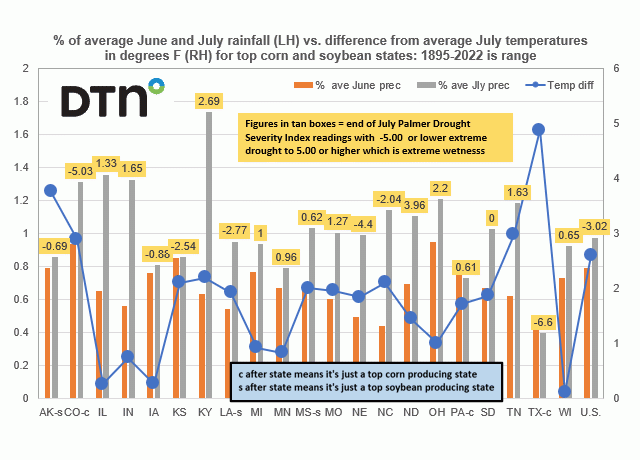Fundamentally Speaking
Precipitation, Temperatures for Top Corn, Soybean States
Earlier this week NOAA released its "Assessing the U.S. Climate in July 2022" report and noted that the average temperature of the contiguous U.S. in July was 76.4°F, which is 2.8°F above average, ranking third warmest in the 128-year record.
Generally, temperatures were above average and/or record-warm across for nearly all the Lower 48, with Texas having its warmest July, May-July and April-July on record.
July precipitation for the contiguous U.S. was 2.74 inches, 0.04 inch below average, ranking in the middle third of the historical record.
Precipitation was above average in pockets across the West Coast, Southwest, Northern Rockies and Plains, Great Lakes and from parts of the Midwest to southern Appalachians, while precipitation was below average across portions of the Northwest, Southern Plains, Upper Midwest and Northeast.
Weather is of course paramount and its impact will have a large bearing on the USDA first crop production figures to be released August 12.
P[L1] D[0x0] M[300x250] OOP[F] ADUNIT[] T[]
We know that the USDA in its weather adjusted yield model looks at both June and July rainfall and July temperatures among other factors.
We report these readings in this graphic that shows June and July 2022 rainfall as a percent of the average 1895-2022 figure on the left-hand axis while on the right-hand axis is the difference of the July 2022 temperature in degrees Fahrenheit from the 1895-2022 July average for the top corn and soybean states and the U.S.
The number in the tan boxes is the end of July Palmer Drought Severity Index (PDSI) readings with -5.00 or lower extreme drought to 5.00 or higher which is extreme wetness.
General observations include that July was rather warm, but rainfall was about average, certainly above that seen in June which, for many states and the U.S., was among the driest ever.
As noted, the U.S. average temperature last month was the third highest ever as all 21 top corn and soybean producing states have readings last month above their respective 1895-2022 averages -- none more so than Texas where their average temperature last month at 87.3 degrees was not only a whopping 4.9 degrees above the average but the hottest July in that state since records started in 1895.
In fact, the south really has been cooking with AR, LA, MS, and TN all seeing their average temperature last month at least in the top eight hottest July's ever.
June was also dry with the U.S. as a whole seeing rainfall of just 2.33 inches which is less than 80% of average and the 11th driest June ever as none of the 21 states saw even average June rainfall with IL, IN, KY, LA, MN, MO, TN and TX quite dry.
Nebraska saw their 6th lowest June precipitation ever and North Carolina with a mere 2.02 inches saw its driest June ever.
The situation appears better for July as only Minnesota at 79.4%, PA at 73.1% and Texas at 39.6% had rainfall last month less than 80% of normal.
Kentucky's July rainfall came in 174% of the 1895-2022 average, a result of the devastating floods.
Finally, a large part of the country is experiencing drought as the end of July U.S. PDSI reading of -3.02 the lowest July reading since 2012 with the Plains states of CO, KS, NE and TX faring the worst.
(c) Copyright 2022 DTN, LLC. All rights reserved.





Comments
To comment, please Log In or Join our Community .